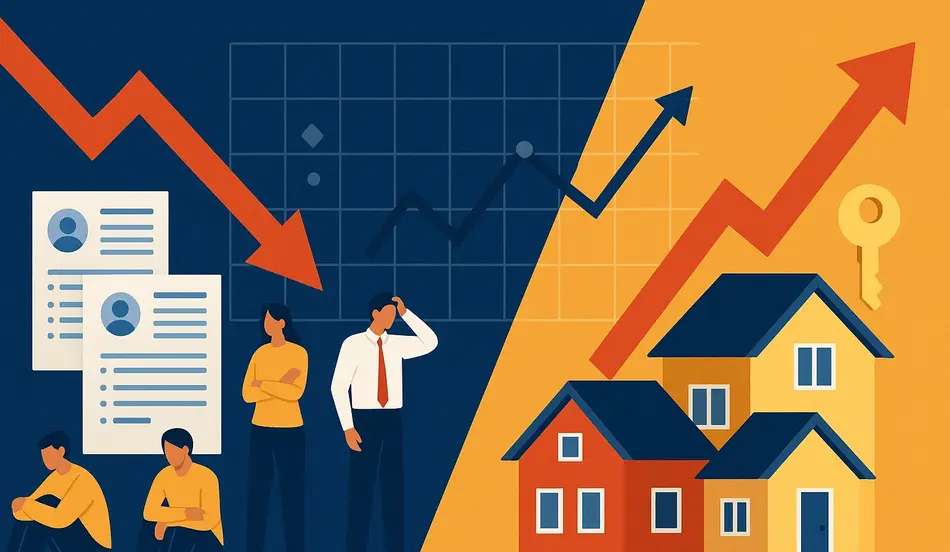Jobless claims housing market data has delivered a stunning rebuke to economic pessimism, showing the US economy growing at its fastest pace in nearly two years. GDP growth of 3.8% and jobless claims falling to 218,000 have created an unprecedented policy dilemma that’s dividing Federal Reserve officials and challenging conventional economic wisdom about the need for aggressive monetary stimulus.
The data reveals a complex economic landscape where strong consumer spending and business investment are driving growth, while inflation remains stubbornly above the Fed’s 2% target. Fed Governor Stephen Myron’s call for rate cuts based on a “drifting down” neutral rate stands in stark contrast to the hawkish stance of other Fed officials who see current policy as only “slightly restrictive” and appropriate for the current economic conditions.
This policy debate isn’t just academic – it has real implications for millions of American families, businesses, and investors who are trying to navigate an uncertain economic environment. The stakes couldn’t be higher as the Fed faces pressure from both political and economic forces that are pulling in opposite directions.
The Economic Data Surprise: Strong Growth Defies Pessimism
The latest economic data has delivered a stunning rebuke to those who predicted economic doom. GDP growth of 3.8% represents the fastest pace in nearly two years, driven primarily by robust consumer spending and increased business investment. This performance contradicts the narrative of an economy in trouble and suggests that current monetary policy may be more appropriate than critics suggest.
The strength of consumer spending is particularly notable, as it represents the largest component of GDP and indicates that American households remain confident about their financial prospects. This confidence is supported by a labor market that continues to show resilience, with jobless claims falling to 218,000 – a level that suggests the job market remains tight despite some cooling in hiring activity.
Business spending has also contributed significantly to growth, with durable goods orders up 2.9% in the latest report. This indicates that companies are continuing to invest in equipment and infrastructure, suggesting they remain optimistic about future economic prospects and are willing to make long-term commitments.
The data also reveals interesting sectoral dynamics, with aircraft orders driving much of the durable goods increase while computer and chip orders declined. This suggests that the economy is experiencing a rotation rather than a broad-based slowdown, with some sectors thriving while others adjust to changing market conditions.
The Two-Speed Economy: Higher Income vs. Lower Income
The economic data reveals a concerning trend that’s creating a two-speed economy where higher-income households are doing most of the heavy lifting when it comes to consumer spending, while lower-income families are struggling to keep up. This divergence is creating social and economic tensions that could have long-term implications for economic stability.
Higher-income households have benefited from strong stock market performance, rising home values, and relatively stable employment in professional sectors. They’re able to maintain their spending patterns and even increase consumption, which is driving much of the GDP growth we’re seeing.
Lower-income households, however, are facing multiple headwinds including higher food costs, energy prices, and housing expenses. They’re being forced to cut back on discretionary spending and are more vulnerable to economic shocks, creating a growing divide in economic outcomes.
This two-speed economy presents a challenge for policymakers who must balance the needs of different economic segments while maintaining overall economic stability. The Fed’s policy decisions must consider both the strength of the overall economy and the struggles of lower-income families.
The Labor Market Conundrum: Low Hiring, Low Firing
The labor market presents a particularly puzzling picture that’s confounding both economists and policymakers. The Fed has been talking about “low hiring but low firing” – a situation where job creation has slowed but layoffs remain minimal. This creates an unusual dynamic where the labor market appears stable despite reduced hiring activity.
Jobless claims falling to 218,000 suggests that employers are holding onto their workers even as they become more cautious about hiring new ones. This behavior pattern indicates that businesses are uncertain about future economic conditions and are adopting a wait-and-see approach rather than making dramatic changes to their workforce.
This labor market dynamic has important implications for monetary policy. If employers are reluctant to hire but also reluctant to fire, it suggests that the labor market may be in a state of equilibrium that doesn’t require aggressive policy intervention. The current unemployment rate and jobless claims data suggest that the labor market remains healthy despite some cooling in hiring activity.
The persistence of this pattern over time suggests that it may reflect structural changes in the labor market rather than cyclical weakness. This could mean that traditional policy responses may not be appropriate for the current situation.
Shocking Numbers Reshaping the Economy
Surging jobless claims and volatile housing market data are rewriting the outlook for businesses and workers alike. Employers can take action now by opening opportunities that drive stability and growth. Post your job on WhatJobs today and connect with candidates ready to make an impact in uncertain times.
Post a Job Free for 30 Days →The Housing Market Challenge: A Catch-22 for First-Time Buyers
The housing market presents a complex picture that’s creating significant challenges for first-time homebuyers. Existing home sales remained flat in August, reflecting the impact of higher mortgage rates that were prevalent during that period. However, the market is showing signs of shifting as mortgage rates have come down in September.
The supply side of the housing market is particularly interesting, with inventory decreasing in August for the first time in many months. This suggests that sellers are becoming more reluctant to list their homes, creating a catch-22 situation for potential buyers who are waiting for better conditions.
First-time homebuyers are caught in a difficult position. They’re waiting for lower interest rates to improve affordability, but the lack of supply is keeping prices elevated. This creates a situation where even when rates come down, the limited inventory makes it difficult to find suitable homes at reasonable prices.
The housing market’s current dynamics highlight the broader economic challenges facing middle-class families who are trying to build wealth through homeownership. The combination of high prices, limited supply, and fluctuating interest rates creates significant barriers to entry for new buyers.
The Mortgage Rate Roller Coaster: What to Expect
Mortgage rates have been on a roller coaster ride, with sharp declines at the beginning of September followed by slight increases in recent weeks. The 30-year fixed mortgage rate tracks the 10-year Treasury yield, which moves based on investor expectations about future interest rates.
The recent decline in mortgage rates reflects investor expectations that the Fed will cut rates multiple times before the end of the year, with only one additional cut expected in 2026. However, much of this expectation has already been priced into the market, which is why rates have started to tick up slightly.
The key factor that will determine the future direction of mortgage rates is inflation data. If inflation continues to show signs of cooling, it could support the case for further rate cuts and lead to lower mortgage rates. However, if inflation remains stubbornly high, it could force the Fed to maintain higher rates for longer.
For homeowners looking to refinance, the current environment presents both opportunities and risks. While rates have come down from their recent highs, they’re still elevated compared to historical levels. The decision to refinance should be based on individual circumstances and long-term financial goals.
The Fed’s Policy Dilemma: Balancing Growth and Inflation
The Fed faces a difficult balancing act as it tries to manage both economic growth and inflation. The strong GDP growth and falling jobless claims suggest that the economy is performing well, but persistent inflation above the 2% target creates pressure to maintain restrictive monetary policy.
Fed Governor Stephen Myron has emerged as the lone voice calling for aggressive rate cuts, arguing that the neutral rate is “drifting down” and that current policy is “excessively restrictive.” However, other Fed officials maintain that current policy is only “slightly restrictive” and appropriate for the current inflation environment.
This internal division reflects the complexity of the current economic environment, where strong growth data conflicts with persistent inflation concerns. The Fed’s decision-making process is being tested by competing economic signals that don’t align with traditional policy frameworks.
The Fed must carefully consider both the strength of the overall economy and the struggles of lower-income families when making policy decisions. The two-speed economy creates additional complexity that traditional policy tools may not be well-suited to address.
A Real-World Example: The First-Time Homebuyer’s Struggle
Sarah Martinez, a 28-year-old marketing coordinator in Austin, Texas, finds herself caught in the middle of the jobless claims housing market data challenges. “I’ve been saving for a down payment for three years, but every time I think I’m close, something changes,” she explains. “First it was rising home prices, then higher interest rates, and now there’s just nothing available in my price range.”
Sarah’s situation illustrates the catch-22 facing many first-time homebuyers. “I’m making more money than ever, and I have good credit, but I still can’t afford a decent home in my area,” she says. “The houses that are available are either too expensive or need too much work, and the ones I can afford get multiple offers within days.”
The economic data shows that while the overall economy is strong, the housing market is creating significant challenges for middle-class families. “I see all these reports about the economy doing well, but it doesn’t feel like that for people like me who are trying to buy their first home,” Sarah explains.
Sarah’s experience highlights the disconnect between macroeconomic data and individual economic experiences. “The job market is strong, and I’m not worried about losing my job, but that doesn’t help me when I’m competing with cash buyers and investors for the few homes that are available,” she says.
The housing market’s current dynamics are forcing many young families to delay homeownership, which could have long-term implications for wealth building and economic mobility. “I’m starting to wonder if I’ll ever be able to buy a home,” Sarah says. “It feels like the system is stacked against first-time buyers like me.”
Don’t Let Policy Confusion Undermine Economic Confidence
The jobless claims housing market data highlights the critical importance of clear, consistent communication from monetary policymakers. While strong economic data suggests that the economy is performing well, the internal division within the Fed is creating uncertainty that could undermine business confidence and investment decisions.
The Fed must find a way to reconcile its internal differences and provide clear guidance to markets and businesses. The current situation, where one governor is calling for aggressive rate cuts while others maintain a more cautious stance, is not sustainable and could lead to policy mistakes that harm the economy.
The strong economic data provides an opportunity for the Fed to take a step back and reassess its policy framework. Rather than rushing to cut rates based on theoretical concerns about the neutral rate, the Fed should focus on the actual economic data and make decisions based on observable trends.
The stakes are too high to allow internal disagreements to create policy confusion. The Fed must speak with one voice and provide clear guidance to help businesses and consumers navigate the current economic environment.




